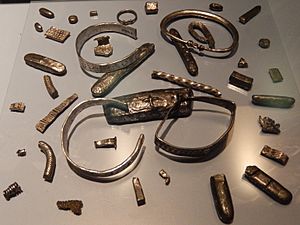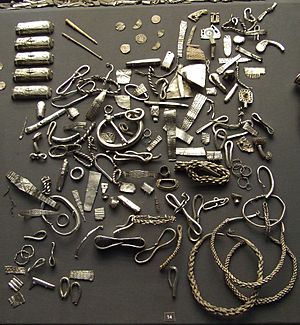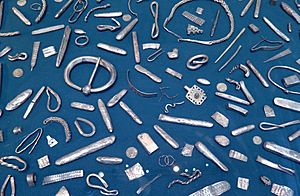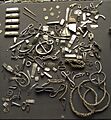Cuerdale Hoard facts for kids
The Cuerdale Hoard is a huge collection of over 8,600 items. It includes shiny silver coins, beautiful jewelry from England and the Carolingian Empire, pieces of cut silver called hacksilver, and silver bars known as ingots. This amazing treasure was found on May 15, 1840. It was hidden on the south bank of the River Ribble, near a place called Cuerdale in Preston, Lancashire, England.
The Cuerdale Hoard is one of the biggest Viking silver treasures ever discovered. It is four times larger than any other similar find in Britain or Ireland. In terms of how much it weighs and how many pieces it has, it's only smaller than the Spillings Hoard found in Gotland, Sweden.
The coins in the hoard came from three main places. Most of them were from the Viking kingdoms of eastern England. The other coins were from King Alfred's Kingdom of Wessex and from many foreign countries. These foreign coins came from places like the Byzantine Empire, Scandinavia, Islamic lands, the Papal States, North Italy, and the Carolingian Empire. Many of the Carolingian coins might have come from Aquitaine during Viking raids around 898.
Contents
Discovering the Cuerdale Hoard
The hoard was found by a group of workmen. They were busy repairing the riverbank when they stumbled upon it. The treasure was hidden inside a lead box. It looked like the items had been carefully placed in small bags or packages inside the box.
After the discovery, the landowner's bailiffs quickly took charge of the hoard. This helped keep the whole treasure together. However, the workmen each managed to keep one coin as a souvenir. The rest of the treasure was officially declared a treasure trove. This meant it belonged to Queen Victoria as the Duke of Lancaster.
The Duchy of Lancaster then gave the main part of the hoard to the British Museum in London. Most of the Cuerdale Hoard is still there today. About 60 special items from the hoard are kept and shown at the Ashmolean Museum in Oxford. Some coins from a place called Quentovic in northern France are held by the Château-musée de Boulogne-sur-Mer.
Who Buried the Cuerdale Hoard?
Experts believe the coins were buried between the years 903 and 910. This was soon after the Vikings were forced out of Dublin in 902. At that time, the Ribble Valley was an important route for Vikings. It connected the Irish Sea to York.
The hoard contains many newly made Norse coins from York. It also has a lot of silver from Irish Norse areas. This makes experts think the hoard might have been a war chest. It could have belonged to Irish Norse exiles. They might have planned to take back Dublin from the Ribble Estuary. However, there are many other ideas about who owned it and why it was buried.
Why Was the Hoard Buried?

In 1966, a coin expert named M. Banks had a different idea. He suggested that the hoard might not have been buried by Vikings at all. Even though it was Viking treasure, or at least a lot of it was, Banks thought it might have been a gift. He believed it was meant for English churches. These churches were suffering because of the pagan Vikings who occupied areas called the Danelaw.
Banks pointed out that many coins seemed to be made across the English Channel. He thought they were probably a gift from Frankish Christians to their fellow Christians in England.
Many mysteries still surround the Cuerdale Hoard. Not much archaeological digging has been done at the site of Cuerdale Hall. Such research might help explain why the treasure was buried in that exact spot. The way the old hall, roads, and fields are arranged suggests there might have been a ford or bridge nearby.
Another theory comes from Rob Curedale, a descendant of the De Keuerdale family. He suggested that Sir Thomas de Molyneux buried the hoard. Sir Thomas lived at Cuerdale Hall and raised an army with help from Irish nobles. This army was meant to support King Richard II. The treasure could have been hundreds of years old. It might have been brought from Ireland at King Richard II's command and then buried at Cuerdale.
Other ideas suggest the silver was meant for a metalworking shop nearby. Remains of old defenses and a moat suggest that a larger building once stood where Cuerdale Hall is now.
Mysterious Coins and Kings
The Cuerdale Hoard has puzzled coin experts for a long time. Many of the coins were very rare or completely new to them. About 3,000 silver pennies were minted for a king named Cnut. On the back, many say "Cunnetti." This might be the name of the town where they were made, but no one knows for sure where that town was. Some think it was Chester-le-Street, or perhaps a place called Cuneet or Cunetio. Even Quentovic in France has been suggested, as Vikings often controlled that port.
Another idea is that "Cunnetti" meant "Cnut's people." So, "Cnut, King of Cnut Rex Cunnetti" might just mean "Cnut, King of Cnut's people." Some even think "Cnut" could be a secret message, standing for "Christus Nostrum Ubique Triumphans," which means "Our Christ (is) everywhere triumphant."
Because of these different ideas, no one is sure who Cnut was, where he ruled, or if he even existed. Other puzzling inscriptions on the coins include "Siefredus," another king's name, and town names like "Orsnaforda" and "Ebraice." Siefred might have been a Viking earl who took over after Cnut. Orsnaforda could be Oxford or Horsforth, and Ebraice might be York or Evreux in France. But these are just guesses.
The hoard also had about 1,800 silver coins made in memory of Saint Eadmund. He was an East Anglian king killed by the Danes in 870 AD. There were also about 850 coins from King Alfred and 50 from his son, Edward the Elder. Over a thousand coins were from Europe, mostly from France, and a few from further east, like Arabic and Byzantine coins.
Most historians believe the Cuerdale Hoard was buried between 903 and 905 AD. This was a difficult time in England. King Alfred had managed to get along with the Vikings, but they controlled the north and east of the country, known as the Danelaw. After Alfred died in 899, the Vikings started raiding again. They attacked Ireland, northwest England, Scotland, and the Isle of Man. They even conquered part of France that later became Normandy.
In such uncertain times, the safest place for treasure was hidden deep in the ground. Vikings loved silver because they didn't have much of it in their homeland. Their raids and the "Danegeld" (tribute money) they took from kings like Ethelred the Unready mean that there are more English 10th-century coins in Scandinavian museums than in British ones.
The Cuerdale Hoard was so large that it almost certainly belonged to a very important person. Perhaps it was a Viking army leader or a king. The Ribble valley and the old Roman town of Ribchester were on important routes. An army might use these routes to march from Yorkshire to North Wales or from Chester to Carlisle. However, the hoard doesn't seem to have been gathered by simple looting. The "Cunnetti" coins and most of the French coins seem to have been made in a short time and in a small area.
The careful way the hoard was packaged suggests it was a special collection of coins and silver bars. It was likely gathered for a specific reason. In 1966, Mr. M Banks suggested the treasure might have been meant to help English churches in the Danelaw. These churches were in financial trouble because of the Viking occupation. He also thought that since many coins were from France, they might have been a gift from French churchmen to their struggling English friends.
However, Dr. C. H. V. Sutherland believed that almost half the coins were made by Vikings in Northumbria. He thought the treasure belonged to a Viking chief and was for his army or for running his lands. Both experts agree that the full secrets of the Cuerdale Hoard are still waiting to be discovered.
Old Stories and Modern Connections
Local Legends of Hidden Treasure
People in Preston had a local story for a long time. They said that if you stood on the south bank of the River Ribble at Walton-le-Dale and looked towards Ribchester, you would be looking at the richest treasure in England. No one knew how this story started or how old it was. People didn't know what the treasure was or exactly where it was hidden.
Skeptics, or people who doubted the story, often made fun of it. They watched as people tried to find the treasure using special sticks or chains. One farmer even plowed his fields twice in 1810, hoping to find something. He only got a bigger crop that autumn! But then, one evening in May 1840, the old story turned out to be true.
The Hoard's Place in History
You can still see signs of the Vikings in Preston today through many place names. The Cuerdale Hoard is a great example of the rich history found around the Preston area. This includes evidence of prehistoric times and important Roman history.
The Cuerdale Hoard was chosen as number 9 on a list of British archaeological finds. Experts at the British Museum picked it for a 2003 BBC Television documentary called Our Top Ten Treasures. The show was presented by Adam Hart-Davis.
Images for kids
-
A selection in the Ashmolean Museum
See also
 In Spanish: Tesoro de Cuerdale para niños
In Spanish: Tesoro de Cuerdale para niños






